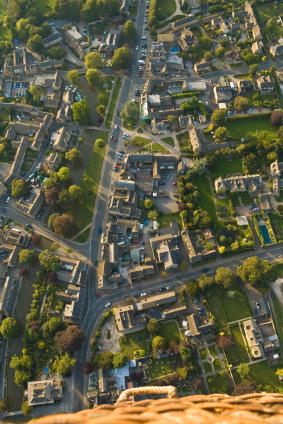
By Joel Kotkin and Mark Schill
Officials in both Presidential campaigns, as well as analysts like Michael Barone, tell us that it is time to “throw out the map”. Yet if we are about the jettison the broad “red” and “blue” markers, perhaps we should explore a very different geographic matrix for this election.
We believe Americans’ political perspective --- if not the final voting behavior --- is largely shaped not so much by their state but by the type of place, they reside in. These define much about an area, such as how many people are homeowners, take transit, have children living at home, the preponderance of middle class households, and the extent economic and racial diversity.
Although not uniform across the country, we believe the most effective breakdown of how Americans live can be seen in three basic geographic forms --- the urban, suburban and what we call “small town/rural”. These geographies show significant differences in almost all major characteristics, including in voting behavior. And even when voting for the same party, they often do so with different motivations.
Democrats in the small cities and towns of the Great Plains, for example, closely follow issues related to agricultural and infrastructure policies that help expand economic opportunities, including energy development. In contrast, urban politics in places like New York, Chicago, or San Francisco tend to have a far greener tinge and concern with social issues such as gay marriage.
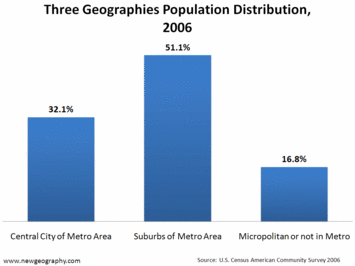 Over the next three months, we plan to break down the country by these three geographies and posit how they live may affect their vote. First thing to do is estimate the size of these three geographies. Examining the census, we believe that urban centers --- that is core cities of our nation’s large metropolitan areas --- represent roughly 32% percent of the total population. The rural/small town component, in many ways the opposite of the urban core, represents roughly 17 percent.
Over the next three months, we plan to break down the country by these three geographies and posit how they live may affect their vote. First thing to do is estimate the size of these three geographies. Examining the census, we believe that urban centers --- that is core cities of our nation’s large metropolitan areas --- represent roughly 32% percent of the total population. The rural/small town component, in many ways the opposite of the urban core, represents roughly 17 percent.
By far the largest percentage of Americans lives in the third geography, the suburbs. Located between the rural edges and the urban cores, this is where Americans have been migrating with remarkable consistency for over a half century. Despite varied attempts to proclaim a “back to the land” or “back to the city” movements, through oil price rises and declines, suburbs have shown no long-term sign of secular shrinking. In fact, during the last six years, roughly 90% of all growth in metropolitan areas has taken place there
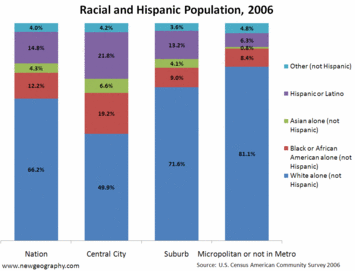 If suburbs, with roughly 51% percent of the population, represent the largest geography, they also, not surprisingly, are most representative of the nation as a whole. Once overwhelmingly white, they now have a racial breakdown far closer to the national norm than either cities, which are much more heavily minority, or rural/small towns, which are considerably less so.
If suburbs, with roughly 51% percent of the population, represent the largest geography, they also, not surprisingly, are most representative of the nation as a whole. Once overwhelmingly white, they now have a racial breakdown far closer to the national norm than either cities, which are much more heavily minority, or rural/small towns, which are considerably less so.
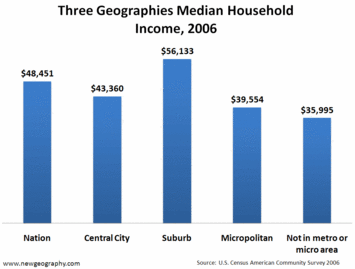 Perhaps more importantly, suburbs tend to have higher concentration of middle class voters than the other geographies. This may explain in part why the suburbs, particularly the outer ring, bore the initial brunt of the mortgage crisis --- suburban households are fifty percent more likely to be owner-occupied but also generally endure higher prices than rural/small town residents. Although their commutes, particularly on the fringes, are not markedly longer than those of urbanities are, they are more dependent on their cars than those who live in such transit oriented cities as New York, Chicago and Boston.
Perhaps more importantly, suburbs tend to have higher concentration of middle class voters than the other geographies. This may explain in part why the suburbs, particularly the outer ring, bore the initial brunt of the mortgage crisis --- suburban households are fifty percent more likely to be owner-occupied but also generally endure higher prices than rural/small town residents. Although their commutes, particularly on the fringes, are not markedly longer than those of urbanities are, they are more dependent on their cars than those who live in such transit oriented cities as New York, Chicago and Boston.
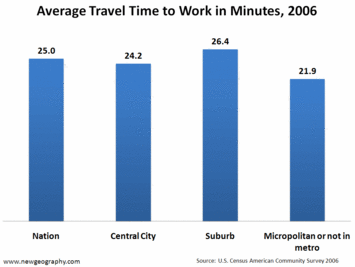 Higher gas prices and the problems with suburban mortgages have some representatives of urban America convinced that their return to national preeminence is imminent. In the last energy crisis during the 1970s, pundits also predicted a similar “back to the city” parade but this did not occur. Actually, over time companies moved their facilities to the suburbs where their workers already had migrated. People also changed their driving habits, most conspicuously by tossing out their gas-guzzlers for more economic models, largely produced by Japanese firms.
Higher gas prices and the problems with suburban mortgages have some representatives of urban America convinced that their return to national preeminence is imminent. In the last energy crisis during the 1970s, pundits also predicted a similar “back to the city” parade but this did not occur. Actually, over time companies moved their facilities to the suburbs where their workers already had migrated. People also changed their driving habits, most conspicuously by tossing out their gas-guzzlers for more economic models, largely produced by Japanese firms.
Other factors should temper urban enthusiasm as well. For one thing, despite the much-ballyhooed revival of central cities, urban areas remain home to most of the highest concentrations of poverty in the nation. What characterizes urban areas, even relatively successful ones such as Chicago, New York and San Francisco, has been their growing bifurcation between extremes of rich and poor. Some , less fabled cities, such as Pittsburgh, even are suffering the ultimate demographic indignity: more people are dying than being born.
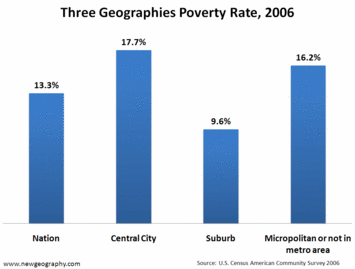 However, in one way urban areas are clearly ascendant: politics. Cities by their nature tend to create coherent, high articulate political, media and economic voices. In contrast, suburban governance generally rests with highly decentralized legislative bodies or in the hands of bland professional managers. Urban America boasts very effective lobbyists and cheerleaders, through both media-savvy Mayors like Michael Bloomberg in New York; well-endowed think tanks, tapping old money sources and developers, serve to promote urban interests. Suburbs, in contrast, generally lack any sense of self-awareness and lack the institutional support to promote their cause.
However, in one way urban areas are clearly ascendant: politics. Cities by their nature tend to create coherent, high articulate political, media and economic voices. In contrast, suburban governance generally rests with highly decentralized legislative bodies or in the hands of bland professional managers. Urban America boasts very effective lobbyists and cheerleaders, through both media-savvy Mayors like Michael Bloomberg in New York; well-endowed think tanks, tapping old money sources and developers, serve to promote urban interests. Suburbs, in contrast, generally lack any sense of self-awareness and lack the institutional support to promote their cause.
A Barack Obama presidency could provide a shot of adrenalin to the urban lobby. Senator Obama illustrates some of the most attractive parts of urbanism such as ethnic diversity, sophistication and a well-articulated commitment to social justice. He also epitomizes some the most turpitudinous, reflected by his ties to the sleazy Chicago machine and links to rent-seeking real estate interests who increasingly, along with public employee unions, dominate urban politics.
Senator Obama’s dominance of the urban geography was complete throughout the primaries and is likely to consolidate even further during the general election. More than any time in the last half-century, Republicans, and even moderate Democrats, are becoming a rare, even endangered species in the big city.
This is bad news for John McCain. He’s the kind of Republican who might have once been thought at least mildly saleable in urban areas. In many ways he suggests the pragmatism of past Republican Mayors such as New York’s Rudy Giuliani, Brent Schundler in Jersey City, Indianapolis’ Stephen Goldsmith and Richard Riordan in Los Angeles. However, in today’s urban political climate, defined by ultra-green and leftist cultural politics, the niche for even these kinds of Republicans seems to have all but evaporated.
Perhaps the most intriguing, and least understood geography can found among the small towns and rural areas. Although they too have become more diverse, overall such communities tend to be poorer, less educated and more homogeneous (in most of the country white) than suburban areas. Yet there are now growing pockets of affluence in parts of this geography, aided by the boom in energy, food, manufacturing and, to some extent, technology related industries.
In the recent past, the Republicans have owned this demographic. Senator Obama, after initial successes in Iowa and Wisconsin, generally did not do well in less prosperous rural/ small town areas in non-caucus states. In contrast, Hillary Clinton, who morphed into more of a populist late in the campaign, clearly touched a nerve in struggling small towns from Nevada to Pennsylvania. Any candidate who speaks about stimulating economic growth and opportunity could appeal to such areas.
There is perhaps a greater opportunity for Senator Obama in those many parts of rural/small town America that are doing well. Although all rural and small town Americans may seem “bitter” --- to use Obama’s unfortunate phrase --- to the urban elites, considerable numbers of small towns are doing better than any time in decades. Plugged into the global economy, internet and their satellites, they are no longer the isolated, bigoted rubes of city imaginings. A forward-looking pro-growth agenda could be surprisingly successful in such places.
Yet in the end, we believe the election will be decided largely in the suburbs, the largest if least self-defined of the geographies. Throughout the primaries, Senator Obama battled Ms. Clinton to a rough draw in the suburbs. He generally did best in the higher end, closer in suburban communities as well as those with large minority population, much as John Kerry did against George Bush in 2002. Now the question is whether he can expand that suburban base to the often less affluent, newer and somewhat more exurban counties.
Senator McCain, from sprawling Phoenix, needs to rally the hard-pressed homeowners and commuters of the suburbs. Recent polls suggest he now holds as much as a ten point lead among suburban voters. To consolidate that advantage, and even expand it, he must offer a vision that promises a future under the next Republican President better than the present one. In contrast, given his lock on the cities, Obama simply needs to split the suburban geography and make a respectable showing in the rural/small towns’ constituency to reach the top of the greasy pole.
Mark Schill contributed to this report, also appearing at Politico.com.
Joel Kotkin is a Presidential Fellow in Urban Futures at Chapman University and executive editor of NewGeography.com. Mark Schill, an associate at Praxis Strategy Group, is the site’s managing editor.
| Attachment | Size |
|---|---|
| 3Geographies-@NewGeography.pdf | 220.88 KB |













Of course, people in rural
Of course, people in rural areas have not time to think about stupid things such as same-sex marriage. The village's people are doing good work. A municipal politicians are concerned to please the citizens who are going crazy from idleness and regret any such fools of gays, lesbians, etc.
platform shoes
high heels shoes
prom shoes girls
pink shoes
wine accessories
310 shoes